When Students Patronize Fast-Food Restaurants near School: The Effects of Identification with the Student Community, Social Activity Spaces and Social Liability Interventions
Abstract
1. Introduction
2. Study 1 Materials, Methods, and Results
2.1. Overview
2.2. Participants
2.3. Measures
2.4. Analyses
2.5. Results
2.6. Discussion
3. Study 2 Materials, Methods, and Results
3.1. Overview
3.2. Design and Participants
3.3. Manipulations
3.4. Measures
3.5. Analyses
3.6. Manipulation Check Results
3.7. Main Results
3.8. Discussion
4. Study 3 Materials, Methods, and Results
4.1. Design and Participants
4.2. Manipulations and Measures
4.3. Manipulation Check Results
4.4. Main Results
4.5. Results on Mediation
4.6. Discussion
5. Study 4 Materials, Methods, and Results
5.1. Design and Participants
5.2. Manipulations and Measures
5.3. Manipulations Check Results
5.4. Restaurant Patronage Intent
5.5. Discussion
6. Study 5 Materials, Methods, and Results
6.1. Design and Participants
6.2. Manipulations and Measures
6.3. Manipulations Check Results
6.4. Main Results
6.5. Discussion
7. Study 6 Materials, Methods, and Results
7.1. Design and Participants
7.2. Manipulations and Measures
7.3. Manipulations Check Results
7.4. Main Results
7.5. Discussion
8. Final Discussion
8.1. Contributions
8.2. Links to Past Literature
8.3. Theoretical and Methodological Contributions
8.4. Limitations
9. Conclusions
Author Contributions
Funding
Institutional Review Board Statement
Informed Consent Statement
Data Availability Statement
Acknowledgments
Conflicts of Interest
Appendix A. Study 1 Supplemental Analyses
| Predictor Variable | Relationship to Fast-food Restaurant Patronage |
|---|---|
| Restaurant near school | b = 0.08, df = 4472, z = 0.55, p = 0.59 |
| Identification with student community | b = −0.20, df = 4472, z = 3.87, p < 0.001 |
| Restaurant near school × identification | b = 0.30, df = 4472, z = 2.94, p < 0.01 |
| Asian | b = −0.10, df = 4472, z = 1.35, p = 0.18 |
| Black | b = −0.20, df = 4472, z = 2.55, p < 0.01 |
| Hispanic | b = −0.12, df = 4472, z = 2.93, p < 0.01 |
| Pacific Islander | b = −0.12, df = 4472, z = 1.08, p = 0.28 |
| White | b = −0.18, df = 4472, z = 2.47, p < 0.01 |
| Mixed ethnicity | b = −0.07, df = 4472, z = 1.01, p = 0.31 |
| Low income (free or reduced-price meals) | b = 0.75, df = 4472, z = 1.77, p = 0.08 |
| School (hierarchical model level 2) | b = 0.00, df = 4472, 95% CI = −0.01, 0.01 |
| County (hierarchical model level 3) | b = 0.25, df = 4472, 95% CI = 0.10, 0.61 |
| Predictor Variable | Relationship to Fast-Food Restaurant Patronage |
|---|---|
| Fast-food restaurant near school | b = 0.08, df = 5980, z = 0.73, p = 0.47 |
| Identification with student community | b = −0.23, df = 5980, z = 2.94, p < 0.01 |
| Near school × identification | b = 0.18, df = 5980, z = 2.25, p < 0.05 |
Appendix B. Study 2 Methodological Details
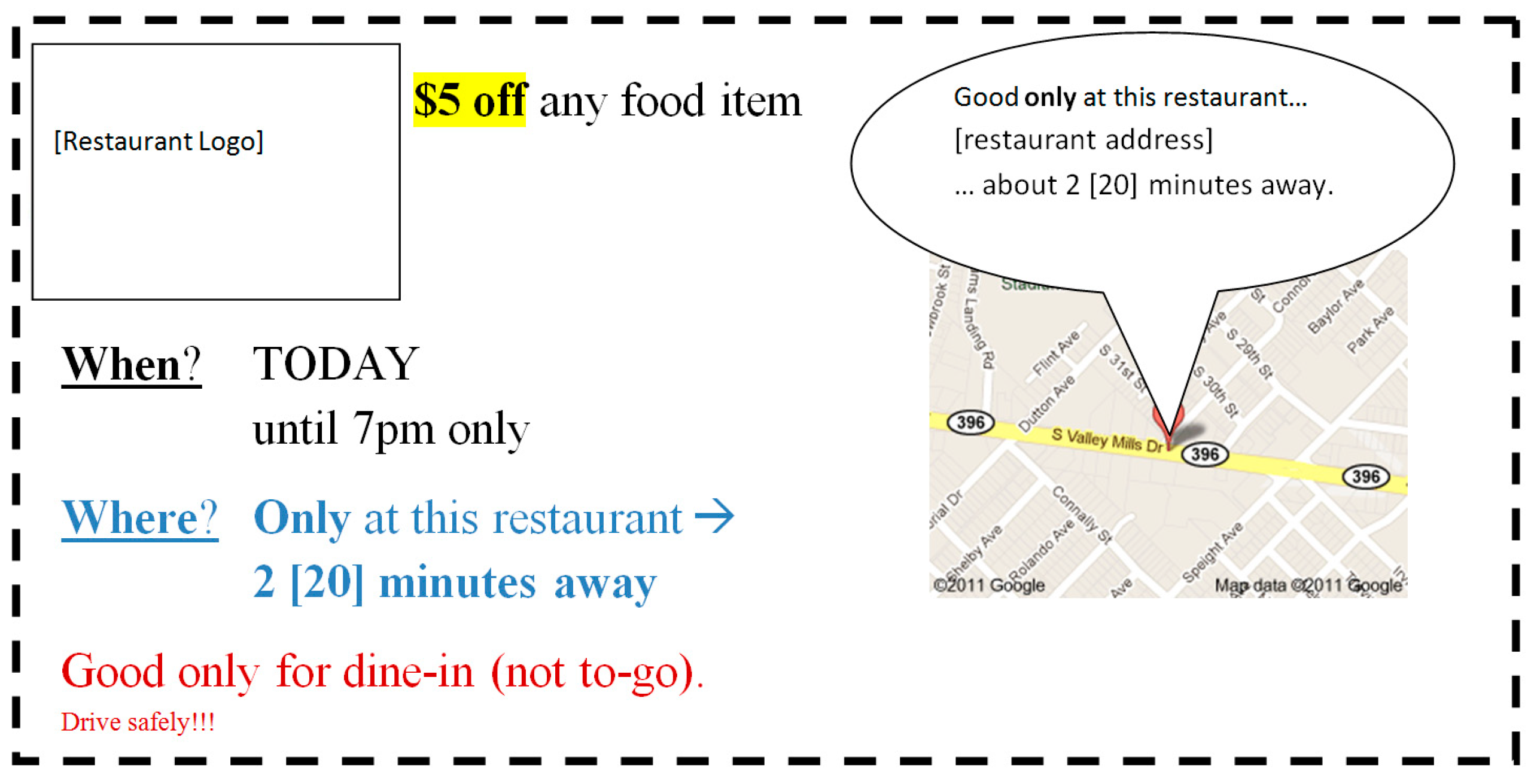
Appendix C. Study 3 Methodological Details

Appendix D. Study 4 Methodological Details
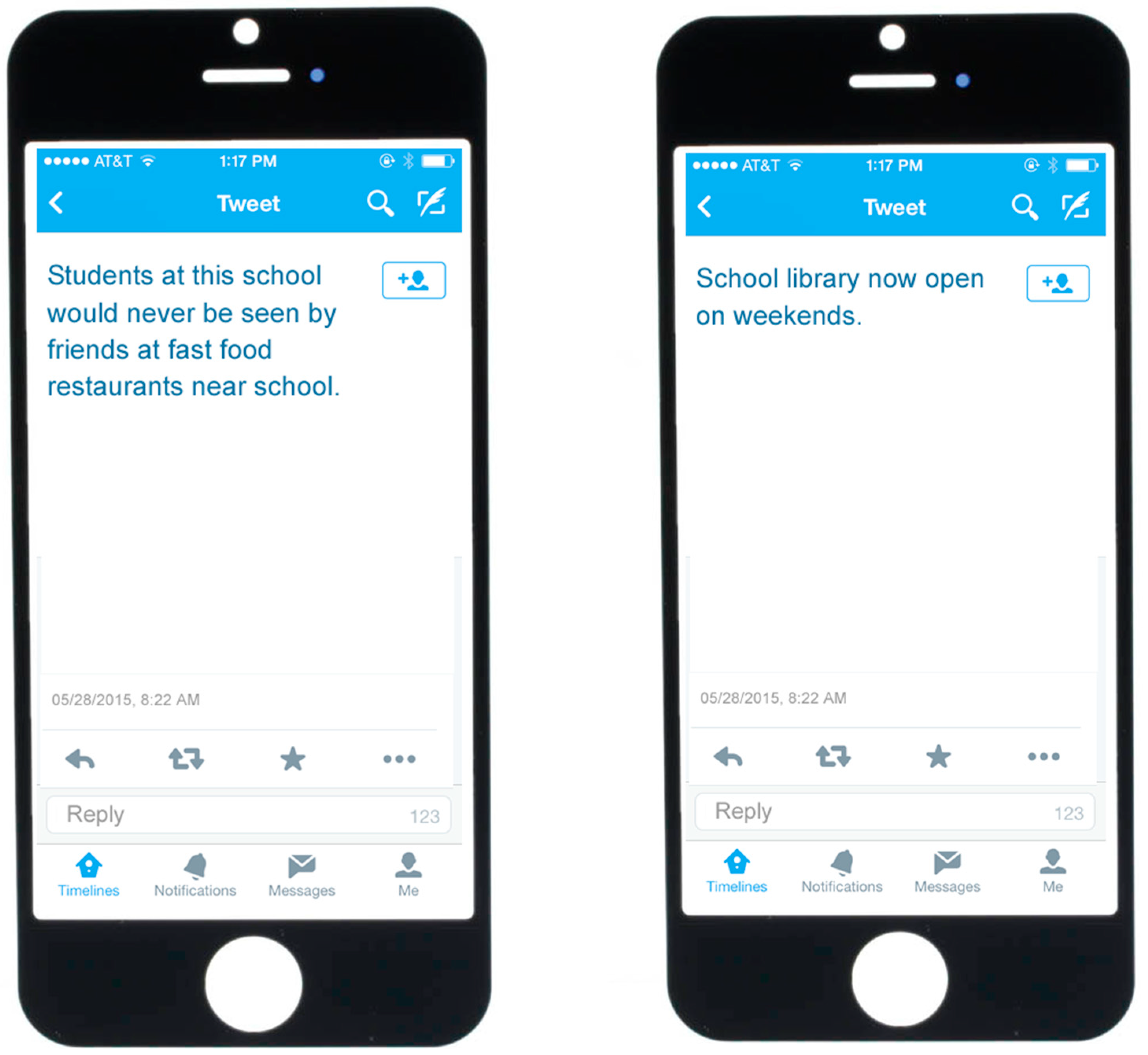
Appendix E. Study 5 Methodological Details

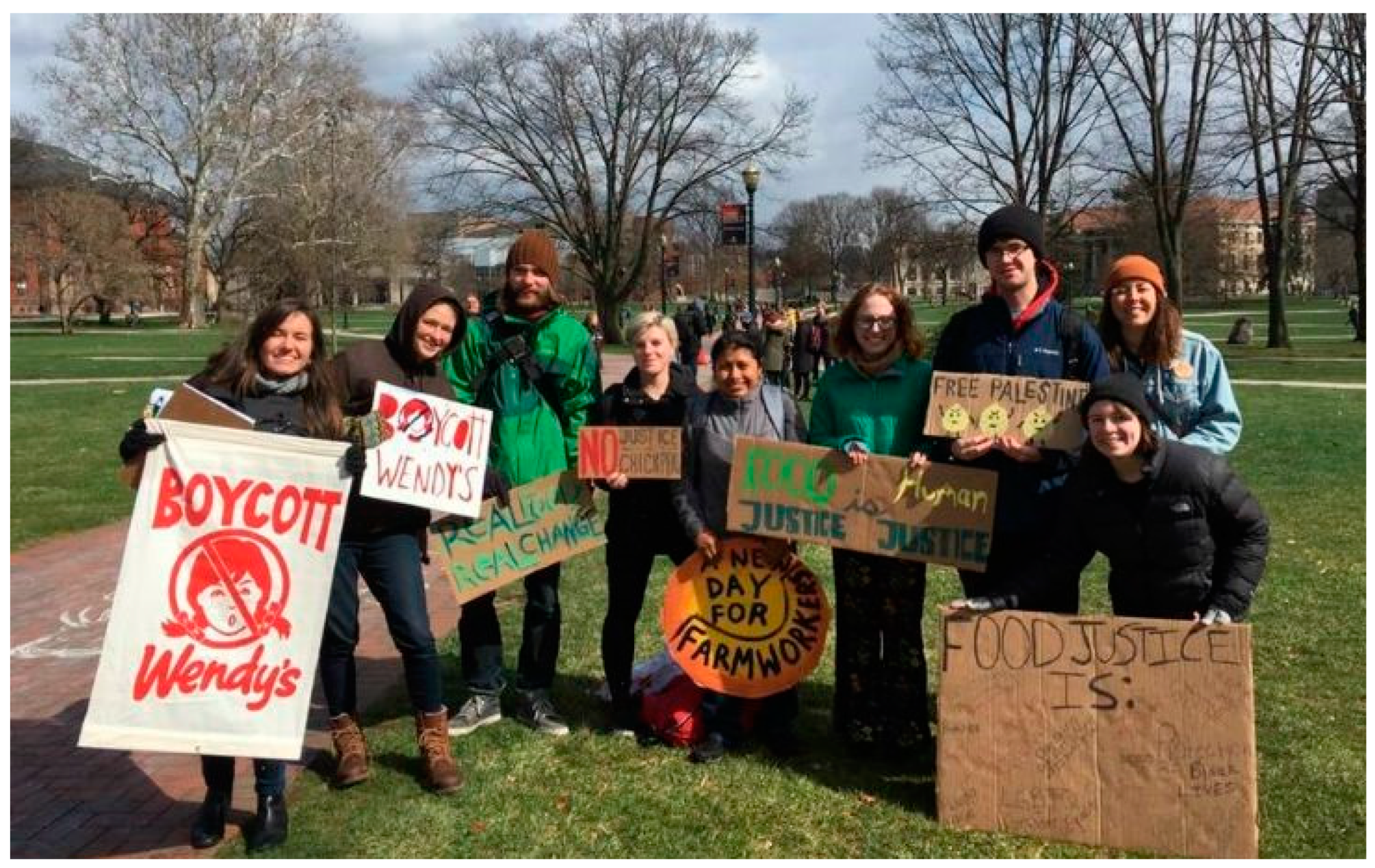
Appendix F. Study 6 Methodological Details
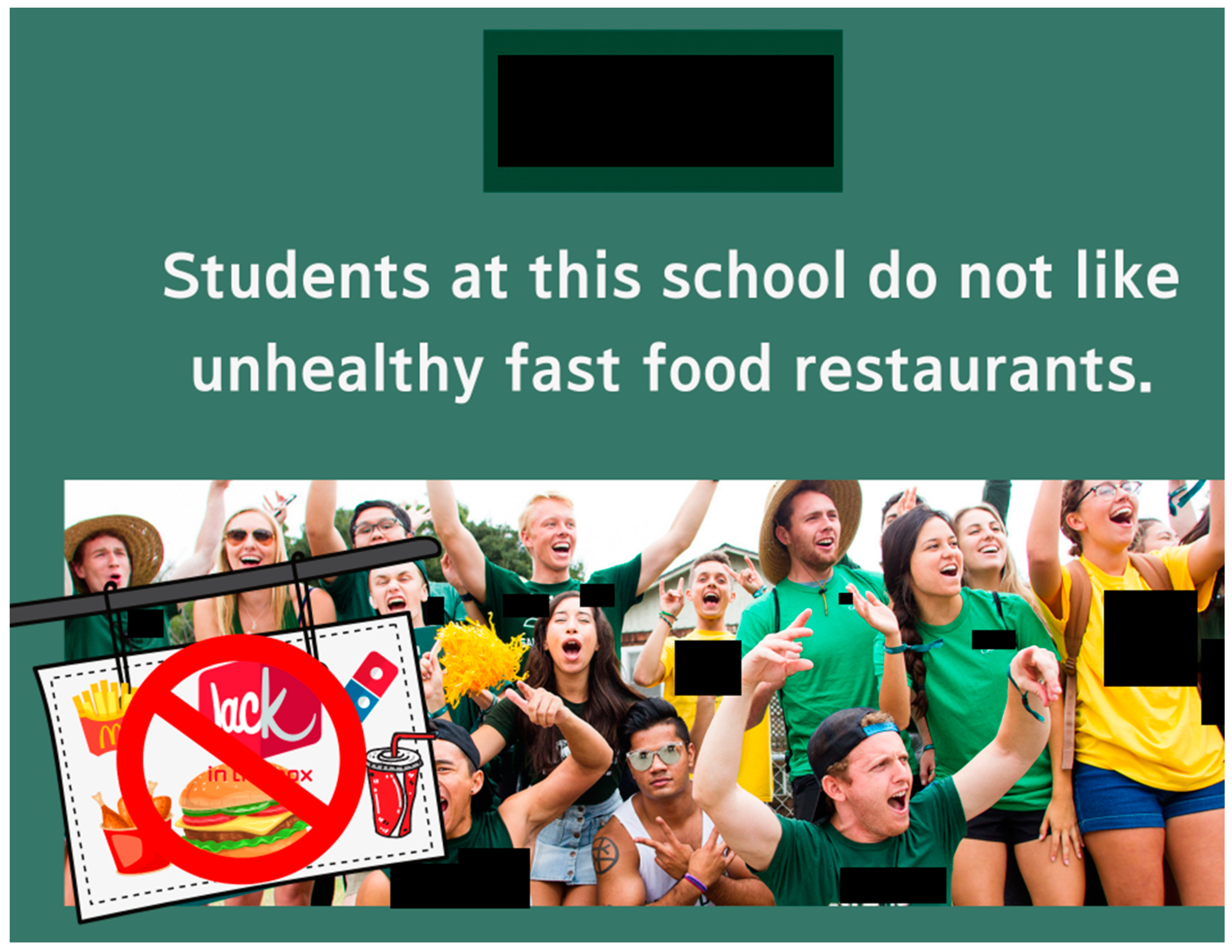

References
- Fraser, L.K.; Edwards, K.L.; Cade, J.; Clarke, G.P. The geography of fast food outlets: A review. Int. J. Environ. Res. Public Health 2010, 7, 2290–2308. [Google Scholar] [CrossRef] [PubMed]
- Davis, B.; Carpenter, C. Proximity of fast-food restaurants to schools and adolescent obesity. Am. J. Public Health 2009, 99, 505–510. [Google Scholar] [CrossRef] [PubMed]
- Grier, S.; Davis, B. Are all proximity effects created equal? Fast food near schools and body weight among diverse adolescents. J. Public Policy Mark. 2013, 32, 116–128. [Google Scholar] [CrossRef]
- Ashe, M.; Jernigan, D.; Kline, R.; Galaz, R. Land use planning and the control of alcohol, tobacco, firearms, and fast food restaurants. Am. J. Public Health 2003, 93, 1404–1408. [Google Scholar] [CrossRef] [PubMed]
- Campbell, C.A.; Hahn, R.A.; Elder, R.; Brewer, R.; Chattopadhyay, S.; Fielding, J.; Naimi, T.S.; Toomey, T.; Lawrence, B.; Middleton, J.C.; et al. The effectiveness of limiting alcohol outlet density as a means of reducing excessive alcohol consumption and alcohol-related harms. Am. J. Prev. Med. 2009, 37, 556–569. [Google Scholar] [CrossRef]
- Marsh, L.; Vaneckova, P.; Robertson, L.; Johnson, T.O.; Doscher, C.; Raskind, I.G.; Schleicher, N.C.; Henriksen, L. Association between density and proximity of tobacco retail outlets with smoking: A systematic review of youth studies. Health Place 2021, 67, 102275. [Google Scholar] [CrossRef] [PubMed]
- Wheeler, D.C.; Boyle, J.; Barsell, D.J.; Glasgow, T.; McClernon, F.J.; Oliver, J.A.; Fuemmeler, B.F. Associations of alcohol and tobacco retail outlet rates with neighborhood disadvantage. Int. J. Environ. Res. Public Health 2022, 19, 1134. [Google Scholar] [CrossRef]
- Hales, C.M.; Fryar, C.D.; Carroll, M.D.; Freedman, D.S.; Ogden, C.L. Trends in Obesity and Severe Obesity Prevalence in US Youth and Adults by Sex and Age, 2007–2008 to 2015–2016. J. Am. Med. Assoc. 2018, 319, 1723–1725. [Google Scholar] [CrossRef]
- Alviola, P.A.; Nayga, R.M.; Thomsen, M.R.; Danforth, D.; Smartt, J. The effect of fast-food restaurants on childhood obesity: A school level analysis. Econ. Hum. Biol. 2014, 12, 110–119. [Google Scholar] [CrossRef]
- Austin, S.B.; Melly, S.J.; Sanchez, B.N.; Patel, A.; Buka, S.; Gortmaker, S.L. Clustering of fast-food restaurants around schools: A novel application of spatial statistics to the study of food environments. Am. J. Public Health 2005, 95, 1575–1581. [Google Scholar] [CrossRef]
- Bauer, K.W.; Larson, N.I.; Nelson, M.C.; Story, M.; Neumark-Sztainer, D. Socio-environmental, personal and behavioural predictors of fast-food intake among adolescents. Public Health Nutr. 2009, 12, 1767–1774. [Google Scholar] [CrossRef] [PubMed]
- Budd, E.L.; Lievanos, R.S.; Amidon, B. Open campus policies: How built, food, social, and organizational environments matter for Oregon’s public high school students’ health. Int. J. Environ. Res. Public Health 2020, 17, 469. [Google Scholar] [CrossRef]
- Cutumisu, N.; Traoré, I.; Paquette, M.-C.; Cazale, L.; Camirand, H.; Lalonde, B.; Robitaille, E. Association between junk food consumption and fast-food outlet access near school among Quebec secondary-school children: Findings from the Quebec Health Survey of High School Students (QHSHSS) 2010–11. Public Health Nutr. 2017, 20, 927–937. [Google Scholar] [CrossRef] [PubMed]
- Matsuzaki, M.; Sánchez, B.N.; Acosta, M.E.; Botkin, J.; Sanchez-Vaznaugh, E.V. Food environment near schools and body weight: A systematic review of associations by race/ethnicity, gender, grade, and socio-economic factors. Obesity 2020, 21, e12997. [Google Scholar] [CrossRef] [PubMed]
- Virtanen, M.; Kivimäki, H.; Ervasti, J.; Oksanen, T.; Pentti, J.; Kouvonen, A.; Halonen, J.I.; Kivimäki, M.; Vahtera, J. Fast-food outlets and grocery stores near school and adolescents’ eating habits and overweight in Finland. Eur. J. Public Health 2015, 25, 650–655. [Google Scholar] [CrossRef]
- Currie, J.; DellaVigna, S.; Moretti, E.; Pathania, V. The effect of fast food restaurants on obesity and weight gain. Am. Econ. J. Econ. Policy 2010, 2, 32–63. [Google Scholar] [CrossRef]
- Hawkes, C. Regulating food marketing to young people worldwide: Trends and policy drivers. Am. J. Public Health 2007, 97, 1962–1973. [Google Scholar] [CrossRef]
- Wang, Y.; Wang, L.; Xue, H.; Qu, W. A review of the growth of the fast food industry in China and its potential impact on obesity. Int. J. Environ. Res. Public Health 2016, 13, 1112. [Google Scholar] [CrossRef]
- CDC. Results from the School Health Policies and Practices Study 2016 2017. Available online: https://www.cdc.gov/healthyyouth/data/shpps/pdf/shpps-results_2016.pdf (accessed on 11 January 2023).
- Prescott, M.P.; Gilbride, J.A.; Corcoran, S.P.; Elbel, B.; Woolf, K.; Ofori, R.O.; Schwartz, A.E. The relationship between school infrastructure and school nutrition program participation and policies in New York City. Int. J. Environ. Res. Public Health 2022, 19, 9649. [Google Scholar] [CrossRef]
- Miura, M. Off the Map: Extracurricular School Food Open Campus Lunch: Public Health Advocacy Institute. 2009. Available online: https://www.phaionline.org/wp-content/uploads/2009/04/otm_open_campus_lunch.pdf (accessed on 11 January 2023).
- Kestens, Y.; Daniel, M. Social Inequalities in Food Exposure around Schools in an Urban Area. Am. J. Prev. Med. 2010, 39, 33–40. [Google Scholar] [CrossRef]
- Sanchez-Vaznaugh, E.V.; Weverka, A.; Matsuzaki, M.; Sánchez, B.N. Changes in fast food outlet availability near schools: Unequal patterns by income, race/ethnicity, and urbanicity. Am. J. Prev. Med. 2019, 57, 338–345. [Google Scholar] [CrossRef] [PubMed]
- Regan, S.D.; Nguyen, N.; Cromley, E.K.; Strong, L.L.; Wetter, D.W.; McNeill, L.H. Density and proximity of fast food restaurants and body mass index among African Americans. Am. J. Public Health 2014, 104, 110–116. [Google Scholar]
- Nixon, L.; Mejia, P.; Dorfman, L.; Cheyne, A.; Young, S.; Friedman, L.C.; Gottlieb, M.A.; Wooten, H. Fast-food fights: News coverage of local efforts to improve food environments through land-use regulations, 2001–2013. Am. J. Public Health 2015, 105, 490–496. [Google Scholar] [CrossRef]
- Sturm, R.; Hattori, A. Diet and obesity in Los Angeles County 2007–2012: Is there a measurable effect of the 2008 ‘Fast-Food Ban’? Soc. Sci. Med. 2015, 133, 205–211. [Google Scholar] [CrossRef] [PubMed]
- Hargreaves, D.; Mates, E.; Menon, P.; Alderman, H.; Devakumar, D.; Fawzi, W.; Greenfield, G.; Hammoudeh, W.; He, S.; Lahiri, A.; et al. Strategies and interventions for healthy adolescent growth, nutrition, and development. Lancet 2022, 399, 198–210. [Google Scholar] [CrossRef] [PubMed]
- Chan, R.S.M.; Woo, J. Prevention of overweight and obesity: How effective is the current public health approach. Int. J. Environ. Res. Public Health 2010, 7, 765–783. [Google Scholar] [CrossRef]
- Browning, C.R.; Soller, B. Moving beyond neighborhood: Activity spaces and ecological networks as contexts for youth development. Cityscape 2014, 16, 165–196. [Google Scholar]
- Patterson, Z.; Farber, S. Potential path areas and activity spaces in application: A review. Transp. Rev. 2015, 35, 679–700. [Google Scholar] [CrossRef]
- Mason, M.; Mennis, J.; Way, T.; Light, J.; Rusby, J.; Westling, E.; Crewe, S.; Flay, B.; Campbell, L.; Zaharakis, N.; et al. Young adolescents’ perceived activity space risk, peer networks, and substance use. Health Place 2015, 34, 143–149. [Google Scholar] [CrossRef]
- Mennis, J.; Mason, M.J. People, places, and adolescent substance use: Integrating activity space and social network data for analyzing health behavior. Ann. Assoc. Am. Geogr. 2011, 101, 272–291. [Google Scholar] [CrossRef]
- Shick, J.F.; Dorus, W.; Hughes, P.H. Adolescent drug using groups in chicago parks. Drug Alcohol Depend. 1978, 3, 199–210. [Google Scholar] [PubMed]
- Van Hoof, J.; Mulder, J.; Korte, J.; Postel, M.; Pieterse, M. Dutch adolescent private drinking places: Prevalence, alcohol consumption, and other risk behaviors. Alcohol 2012, 46, 687–693. [Google Scholar] [CrossRef] [PubMed]
- Blader, S.L. What determines people’s fairness judgments? Identification and outcomes influence procedural justice evaluations under uncertainty. J. Exp. Soc. Psychol. 2007, 43, 986–994. [Google Scholar] [CrossRef]
- Scholl, A.; Sassenberg, K.; Pfattheicher, S. Pressured to be excellent? Social identification prevents negative affect from high university excellence norms. J. Exp. Soc. Psychol. 2019, 84, 103796. [Google Scholar] [CrossRef]
- Tropp, L.R.; Wright, S.C. Ingroup identification as the inclusion of ingroup in the self. Personal. Soc. Psychol. Bull. 2001, 27, 585–600. [Google Scholar] [CrossRef]
- Voelkl, K.E. Measuring students’ identification with school. Educ. Psychol. Meas. 1996, 56, 760–770. [Google Scholar] [CrossRef]
- Voelkl, K.E. Identification with school. Am. J. Educ. 1997, 105, 294–318. [Google Scholar] [CrossRef]
- Eccles, J.S.; Barber, B.L. Student council, volunteering, basketball, or marching band: What kind of extracurricular involvement matters? J. Adolesc. Res. 1999, 14, 10–43. [Google Scholar] [CrossRef]
- Lisha, N.E.; Sussman, S. Relationship of high school and college sports participation with alcohol, tobacco, and illicit drug use: A review. Addict. Behav. 2010, 35, 399–407. [Google Scholar] [CrossRef]
- Marsh, H.W.; Kleitman, S. School athletic participation: Mostly gain with little pain. J. Sport Exerc. Psychol. 2003, 25, 205–228. [Google Scholar] [CrossRef]
- Mitchell, R.M.; Kensler, L.; Tschannen-Moran, M. Student trust in teachers and student perceptions of safety: Positive predictors of student identification with school. Int. J. Leadersh. Educ. 2018, 21, 135–154. [Google Scholar] [CrossRef]
- Wilkins, S.; Butt, M.M.; Daniel Kratochvil, D.; Balakrishnan, M.S. The effects of social identification and organizational identification on student commitment, achievement and satisfaction in higher education. Stud. High. Educ. 2016, 41, 2232–2252. [Google Scholar] [CrossRef]
- Bartholow, B.D.; Loersch, C.; Ito, T.A.; Levsen, M.P.; Volpert-Esmond, H.I.; Fleming, K.A.; Bolls, P.; Carter, B.K. University-affiliated alcohol marketing enhances the incentive salience of alcohol cues. Psychol. Sci. 2018, 29, 83–94. [Google Scholar] [CrossRef] [PubMed]
- Eitle, D.; Turner, R.J.; Eitle, T.M. The deterrence hypothesis reexamined: Sports participation and substance use among young adults. J. Drug Issues 2003, 33, 193–221. [Google Scholar] [CrossRef]
- Berger, J.; Rand, L. Shifting signals to help health: Using identity signaling to reduce risky health behaviors. J. Consum. Res. 2008, 35, 509–518. [Google Scholar] [CrossRef]
- Hsu, M.S.H.; Rouf, A.; Allman-Farinelli, M. Effectiveness and behavioral mechanisms of social media interventions for positive nutrition behaviors in adolescents: A systematic review. J. Adolesc. Health 2018, 63, 531–545. [Google Scholar] [CrossRef]
- DeJong, W.; Winsten, J.A. The use of designated drivers by U.S. college students: A national study. J. Am. Coll. Health 1999, 47, 151–156. [Google Scholar] [CrossRef]
- Slater, M.D.; Kelly, K.J.; Edwards, R.W.; Thurman, P.J.; Plested, B.A.; Keefe, T.J.; Lawrence, F.R.; Henry, K.L. Combining in-school and community-based media efforts: Reducing marijuana and alcohol uptake among younger adolescents. Health Educ. Res. 2006, 21, 157–167. [Google Scholar] [CrossRef]
- Andrews, J.C.; Netemeyer, R.G.; Kees, J.; Burton, S. How graphic visual health warnings affect young smokers’ thoughts of quitting. J. Mark. Res. 2014, 51, 165–183. [Google Scholar] [CrossRef]
- Carpenter, C.S.; Pechmann, C. Exposure to the above the influence antidrug advertisements and adolescent marijuana use in the United States, 2006–2008. Am. J. Public Health 2011, 101, 948–954. [Google Scholar] [CrossRef]
- Zhao, G.; Pechmann, C. The impact of regulatory focus on adolescents’ response to antismoking advertising campaigns. J. Mark. Res. 2007, 44, 671–687. [Google Scholar] [CrossRef]
- Mahoney, J.L.; Stattin, H. Leisure activities and adolescent antisocial behavior: The role of structure and social context. J. Adolesc. 2000, 23, 113–127. [Google Scholar] [CrossRef] [PubMed]
- Pechmann, C.; Knight, S.J. An experimental investigation of the joint effects of advertising and peers on adolescents’ beliefs and intentions about cigarette consumption. J. Consum. Res. 2002, 29, 5–19. [Google Scholar] [CrossRef]
- Pechmann, C.; Wang, L. Effects of indirectly and directly competing reference group messages and persuasion knowledge: Implications for educational placements. J. Mark. Res. 2010, 47, 134–145. [Google Scholar] [CrossRef]
- Pechmann, C.; Shih, C.F. Smoking scenes in movies and antismoking advertisements before movies: Effects on youth. J. Mark. 1999, 63, 1–13. [Google Scholar] [CrossRef]
- Pechmann, C.; Zhao, G.; Goldberg, M.E.; Reibling, E.T. What to convey in antismoking advertisements for adolescents? The use of protection motivation theory to identify effective message themes. J. Mark. 2003, 67, 1–18. [Google Scholar] [CrossRef]
- Sly, D.F.; Heald, G.R.; Ray, S. The Florida ‘truth’ anti-tobacco media evaluations: Design, first year results, and implications for planning future state media evaluations. Tob. Control 2001, 10, 9–15. [Google Scholar] [CrossRef]
- Sly, D.F.; Hopkins, R.S.; Trapido, E.; Ray, S. Influence of a counteradvertising media campaign on initiation of smoking: The Florida “truth” campaign. Am. J. Public Health 2001, 91, 233–238. [Google Scholar]
- Sly, D.F.; Trapido, E.; Ray, S. Evidence of the dose effects of an antitobacco counteradvertising campaign. Prev. Med. 2002, 35, 511–518. [Google Scholar] [CrossRef]
- Thrasher, J.F.; Niederdeppe, J.; Farrelly, M.C.; Davis, K.C.; Ribisl, K.M.; Haviland, M.L. The impact of anti-tobacco industry prevention messages in tobacco producing regions: Evidence from the US truth campaign. Tob. Control 2004, 13, 283–288. [Google Scholar] [CrossRef]
- Russo, R.G.; Ali, S.H.; Mezzacca, T.A.; Radee, A.; Chong, S.; Kranick, J.; Tsui, F.; Foster, V.; Kwon, S.C.; Yi, S.S. Assessing changes in the food retail environment during the COVID-19 pandemic: Opportunities, challenges, and lessons learned. BMC Public Health 2022, 22, 778. [Google Scholar] [CrossRef] [PubMed]
- Wong, M.S.; Peyton, J.M.; Shields, T.M.; Curriero, F.C.; Gudzune, K.A. Comparing the accuracy of food outlet datasets in an urban environment. Geospat. Health 2017, 12, 546. [Google Scholar] [CrossRef]
- Forsyth, A.; Wall, M.; Larson, N.; Story, M.; Neumark-Sztainer, D. Do adolescents who live or go to school near fast-food restaurants eat more frequently from fast-food restaurants? Health Place 2012, 18, 1261–1269. [Google Scholar] [CrossRef] [PubMed]
- Spiller, S.A.; Fitzsimons, G.J.; Lynch, J.G.; McClelland, G.H. Spotlights, floodlights, and the magic number zero: Simple effects tests in moderated regression. J. Mark. Res. 2013, 50, 277–288. [Google Scholar] [CrossRef]
- Kang, Y.-S.; Herr, P.M.; Page, C.M. Time and distance: Asymmetries in consumer trip knowledge and judgments. J. Consum. Res. 2003, 30, 420–429. [Google Scholar] [CrossRef]
- Zhang, M.; Wang, J. Psychological distance asymmetry: The spatial dimension vs. other dimensions. J. Consum. Psychol. 2009, 19, 497–507. [Google Scholar] [CrossRef]
- McFerran, B.; Dahl Darren, W.; Fitzsimons Gavan, J.; Morales Andrea, C. I’ll have what she’s having: Effects of social influence and body type on the food choices of others. J. Consum. Res. 2009, 36, 915–929. [Google Scholar] [CrossRef]
- Hayes, A.F. Introduction to Mediation, Moderation, and Conditional Process Analysis: A Regression-Based Approach; Guilford Press: New York, NY, USA, 2013. [Google Scholar]
- Korkzan, S. Ohio state students fast, protest against university’s lease renewal with fast-food chain Wendy’s. Natl. Cathol. Report. 2017. [Google Scholar]
- Bradford, T.W. We can fix this! Donor activism for nonprofit supply generation. J. Acad. Mark. Sci. 2021, 49, 397–417. [Google Scholar] [CrossRef]
- Boeck, M.; Juillard, C.; Dicker, R.; Joseph, B.; Sakran, J. Turning value into action: Healthcare workers using digital media advocacy to drive change. PLoS ONE 2021, 16, e0250875. [Google Scholar] [CrossRef]
- Hydock, C.; Paharia, N.; Blair, S. Should your brand pick a side? How market share determines the impact of corporate political advocacy. J. Mark. Res. 2020, 57, 1135–1151. [Google Scholar] [CrossRef]
- Herman, C.P.; Roth, D.; Polivy, J. Effects of the presence of others on food intake: A normative interpretation. Psychol. Bull. 2003, 129, 873–886. [Google Scholar] [CrossRef] [PubMed]
- Burger, J.M.; Bell, H.; Harvey, K.; Johnson, J.; Stewart, C.; Dorian, K.; Swedroe, M. Nutritious or delicious? The effect of descriptive norm information on food choice. J. Soc. Clin. Psychol. 2010, 29, 228–242. [Google Scholar] [CrossRef]
- Amiraian, D.; Sobal, J. Dating and eating. Beliefs about dating foods among university students. Appetite 2009, 53, 226–232. [Google Scholar] [CrossRef]
- Ennett, S.T.; Bauman, K.E.; Hussong, A.; Faris, R.; Foshee, V.A.; Cai, L.; DuRant, R.H. The peer context of adolescent substance use: Findings from social network analysis. J. Res. Adolesc. 2006, 16, 159–186. [Google Scholar] [CrossRef]
- Pechmann, C.; Levine, L.; Loughlin, S.; Leslie, F. Impulsive and self-conscious: Adolescents’ vulnerability to advertising and promotion. J. Public Policy Mark. 2005, 24, 202–221. [Google Scholar] [CrossRef]
- Lantz, P.M.; Jacobson, P.D.; Warner, K.E.; Wasserman, J.; Pollack, H.A.; Berson, J.; Ahlstrom, A. Investing in youth tobacco control: A review of smoking prevention and control strategies. Tob. Control 2000, 9, 47–63. [Google Scholar] [CrossRef]
- Skara, S.; Sussman, S. A review of 25 long-term adolescent tobacco and other drug use prevention program evaluations. Prev. Med. 2003, 37, 451–474. [Google Scholar] [CrossRef]
- Erikson, E.H. Identity: Youth and Crisis; WW Norton & Company: New York, NY, USA, 1968. [Google Scholar]
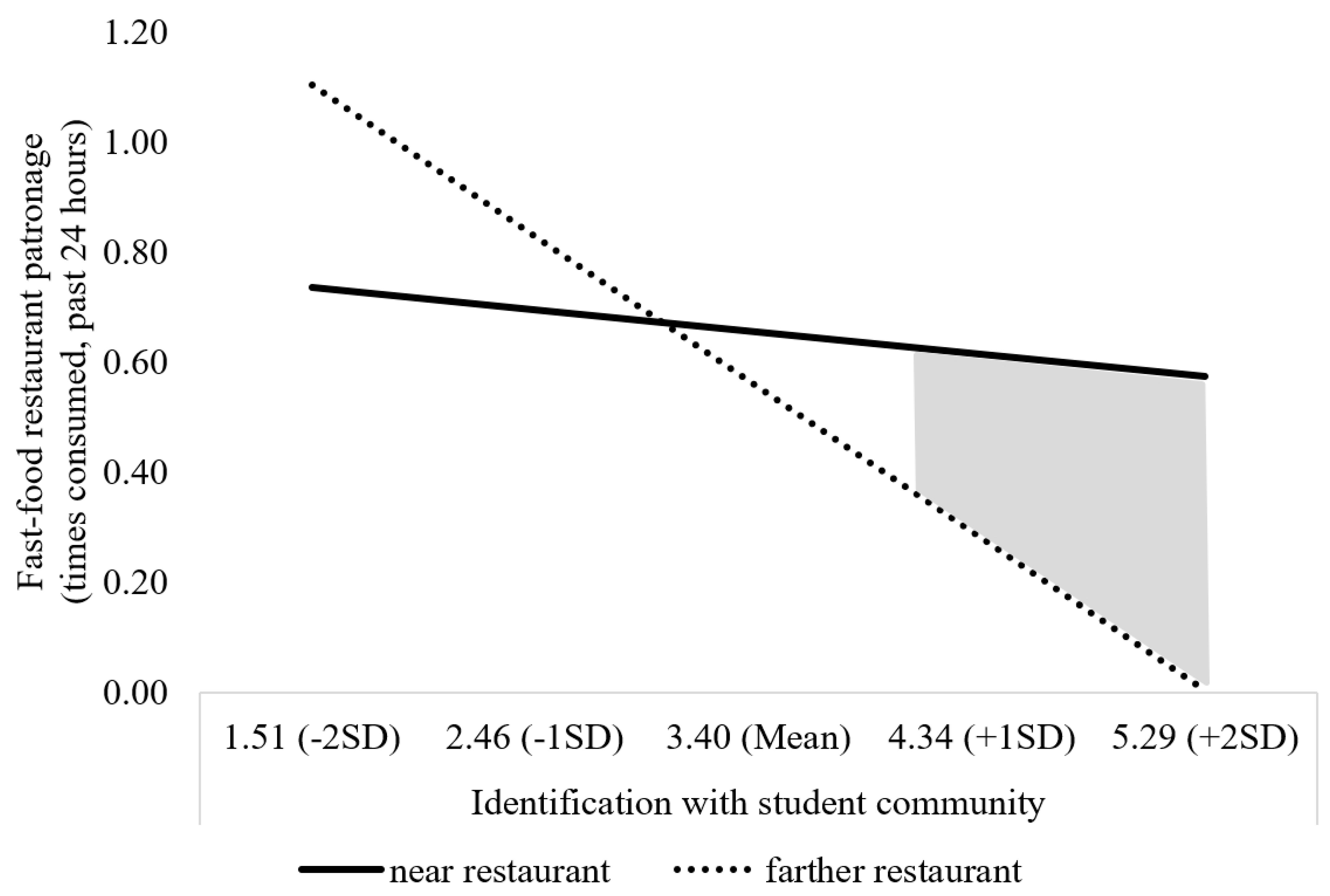
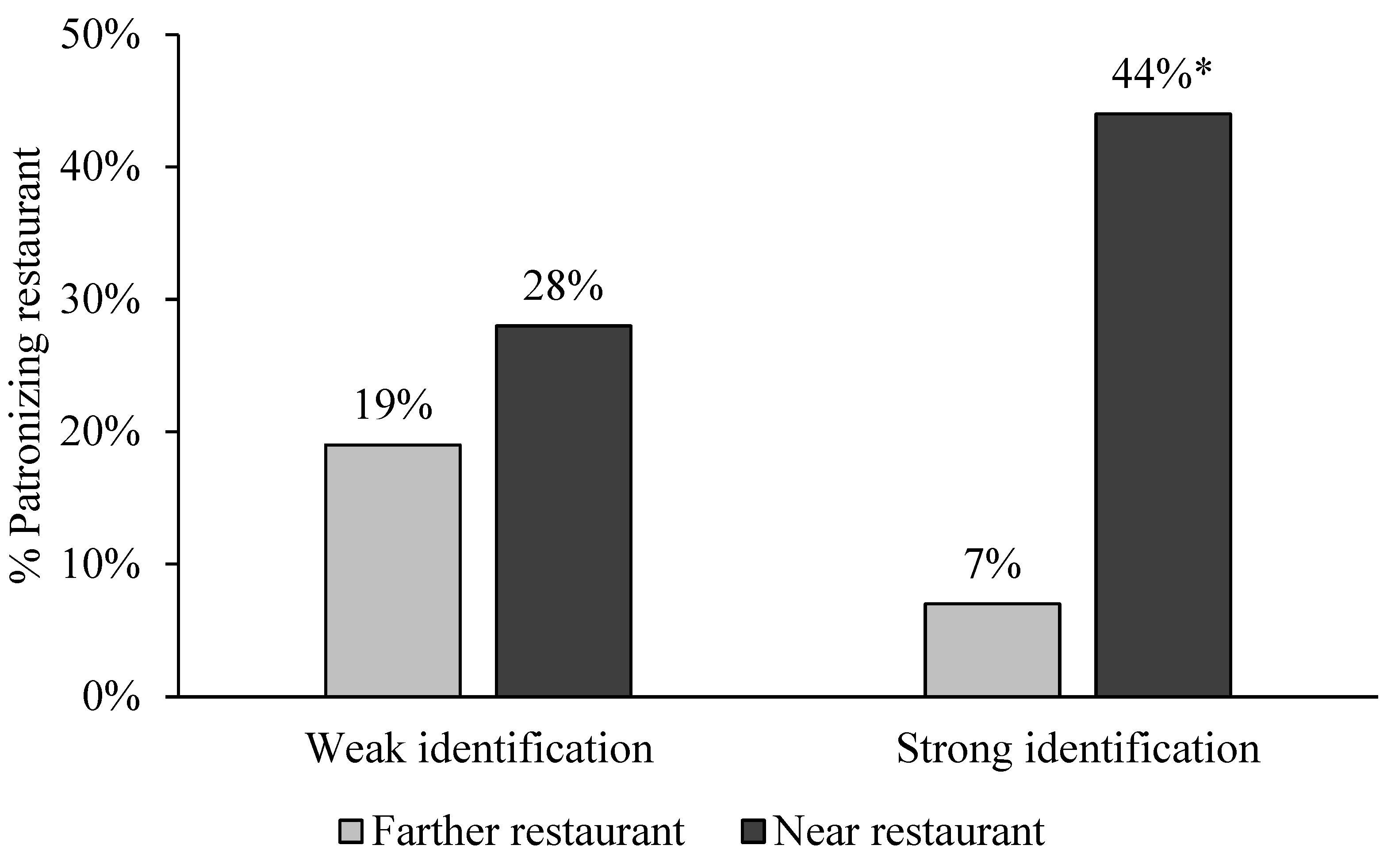
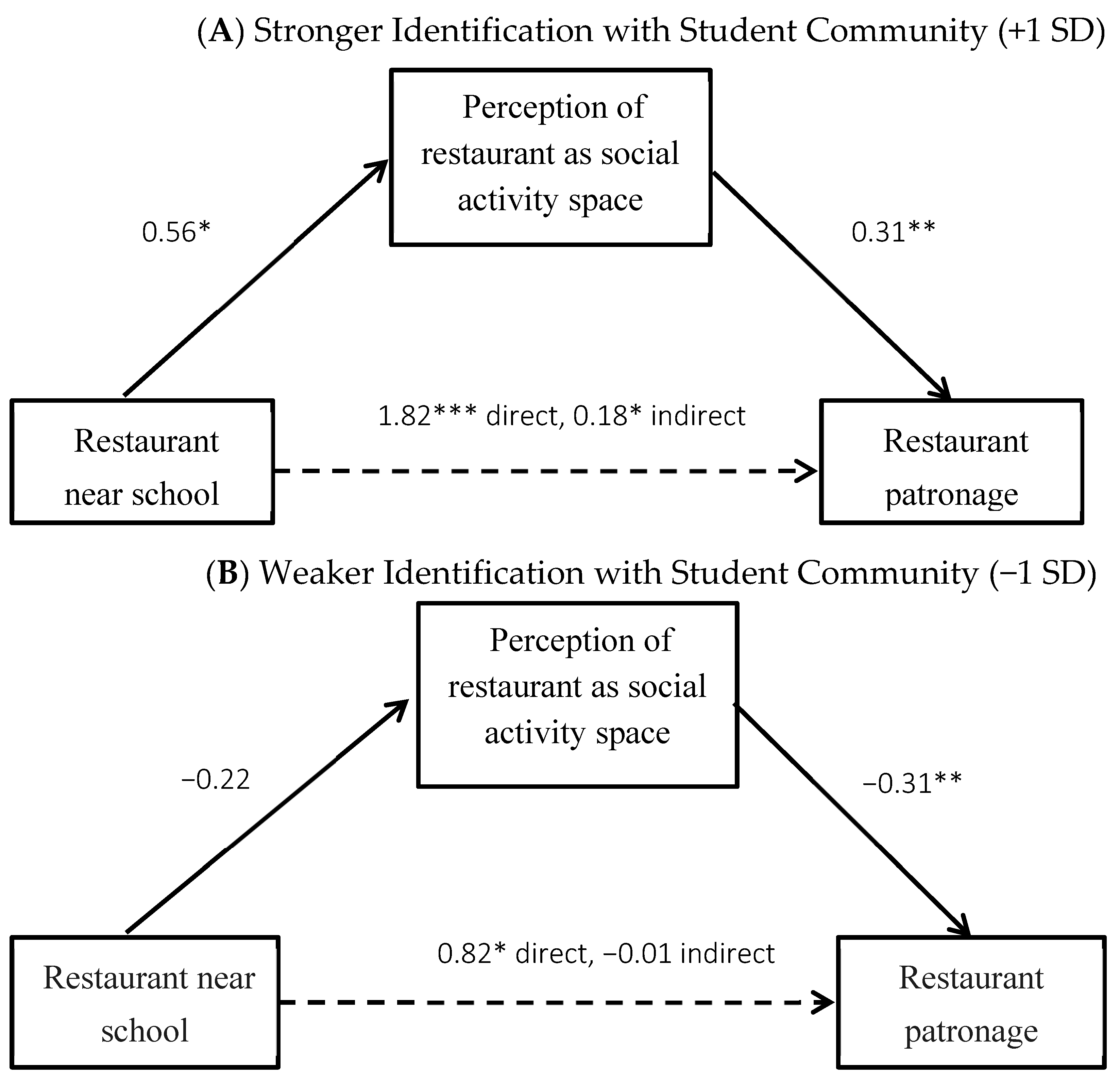
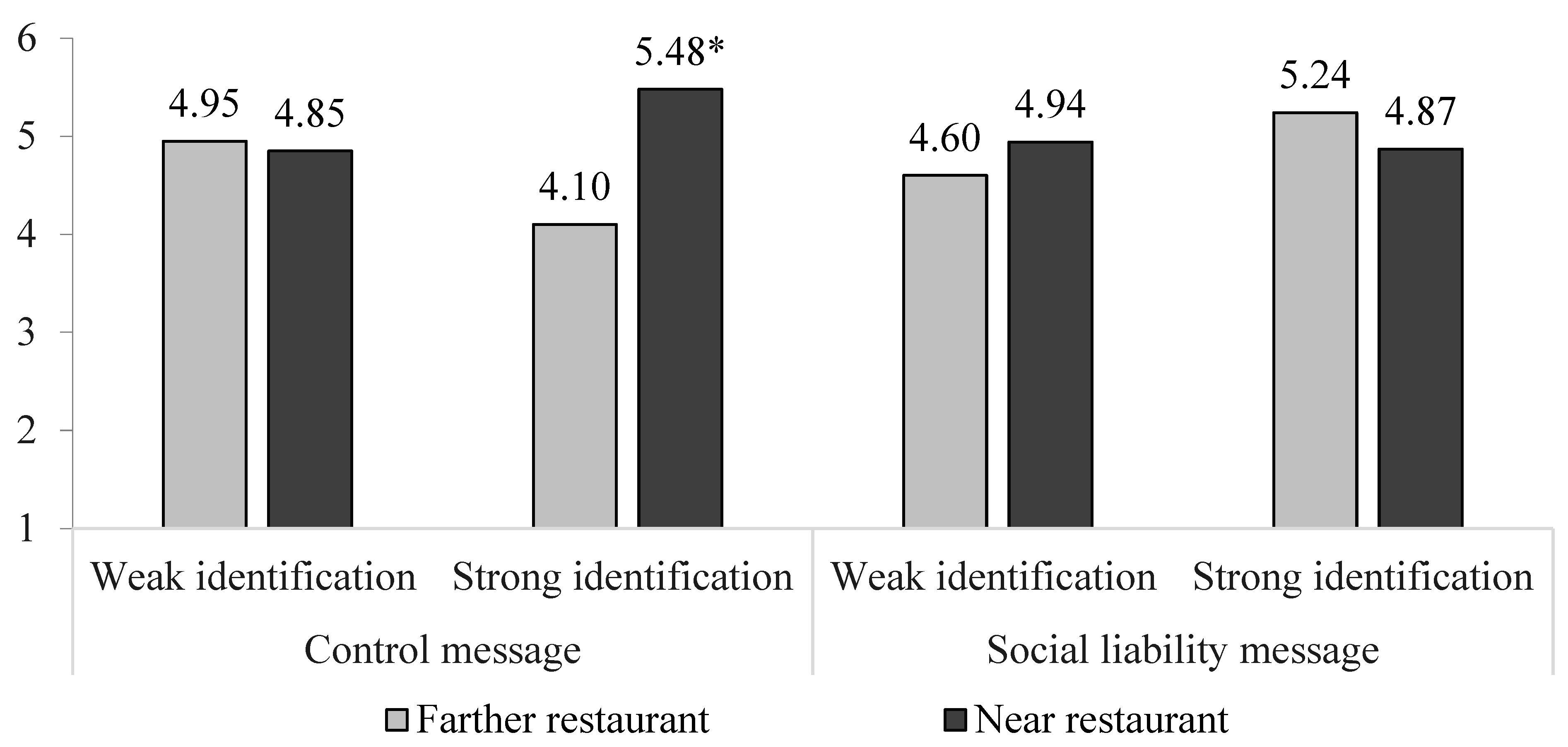
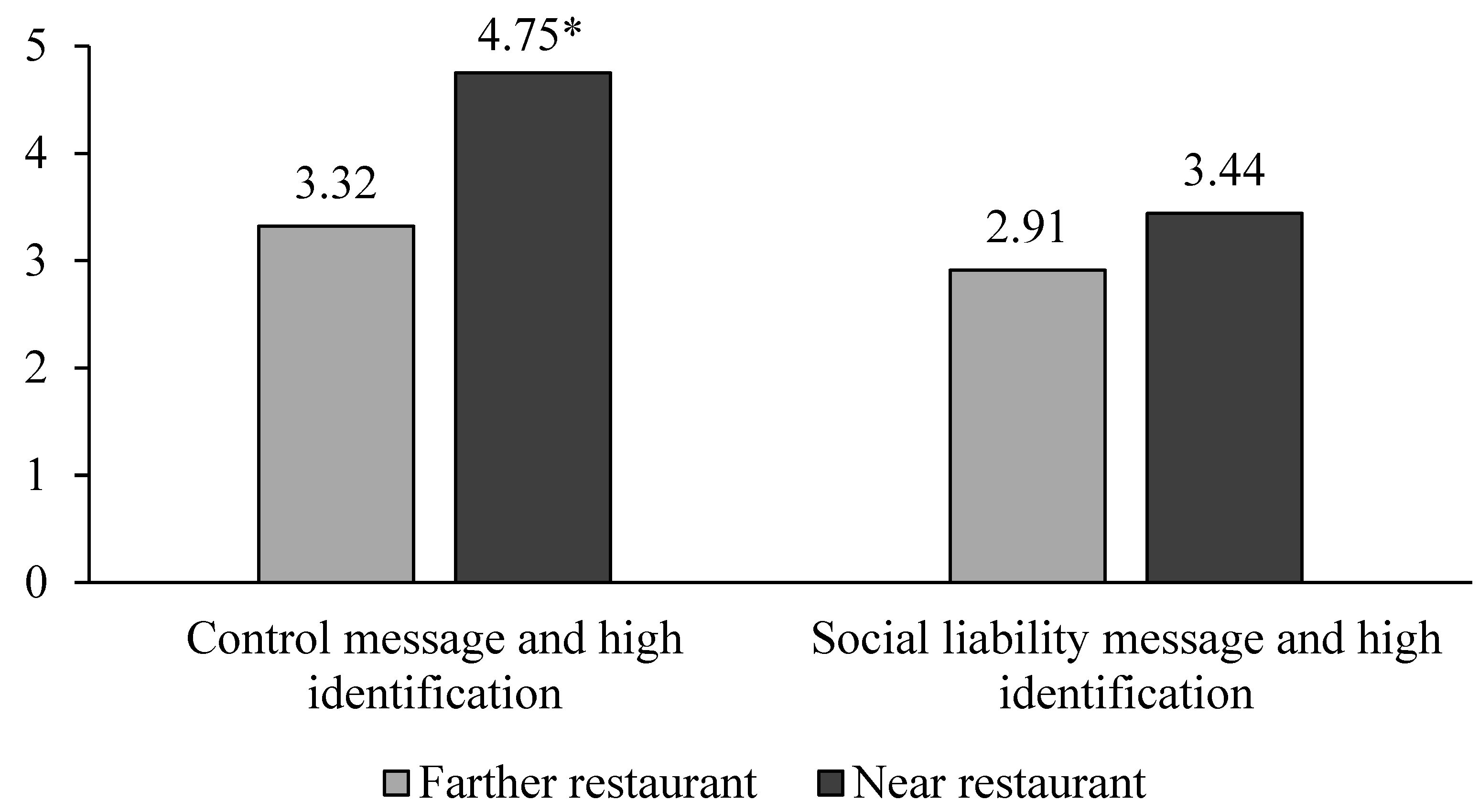
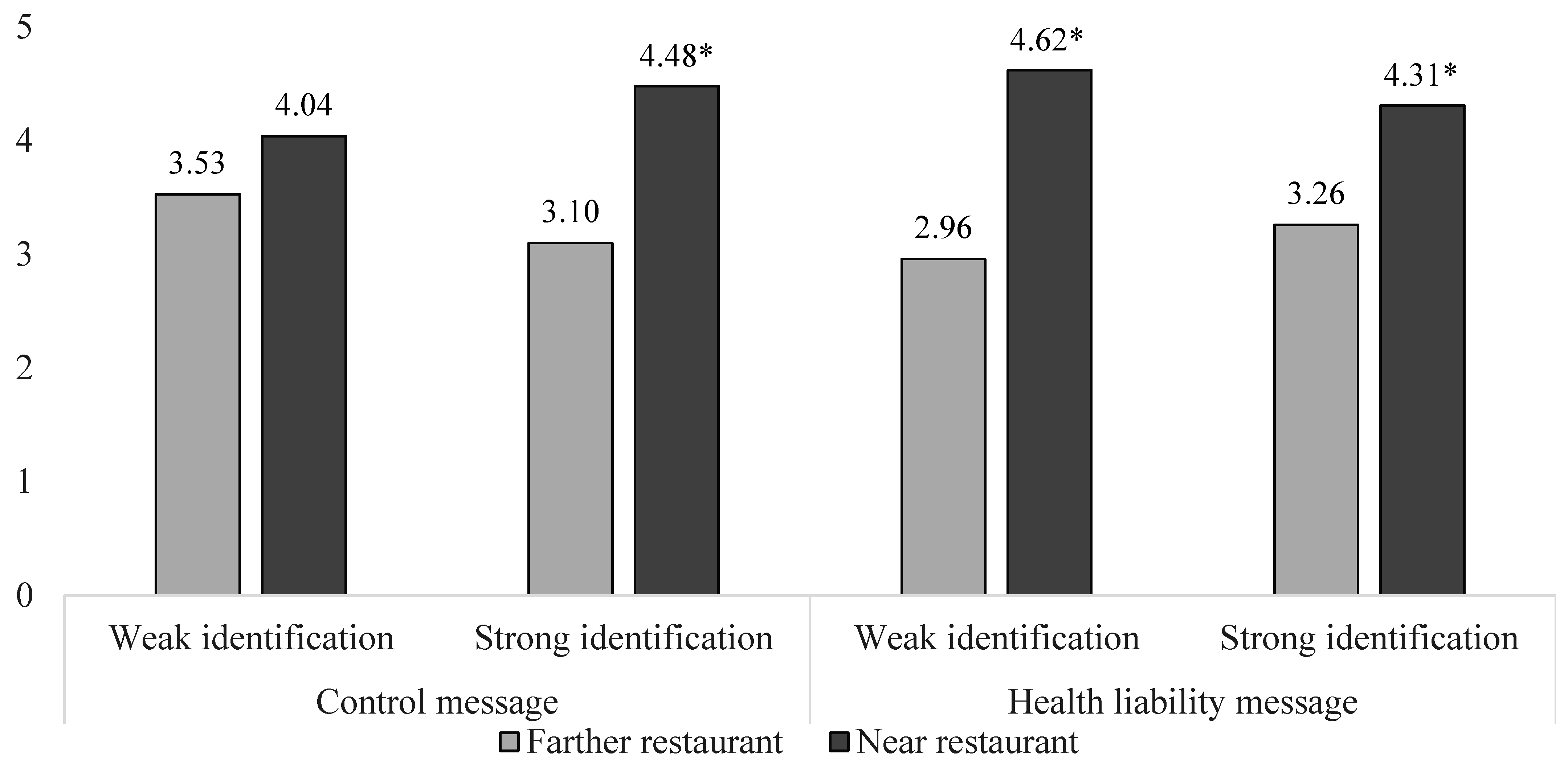
| Predictor Variable | Relationship to Fast-food Restaurant Patronage * |
|---|---|
| Fast-food restaurant near school | b = 0.10, df = 5980, z = 0.85, p = 0.40 |
| Identification with student community | b = −0.16, df = 5980, z = 3.79, p < 0.001 |
| Near school × identification | b = 0.23, df = 5980, z = 2.81, p < 0.01 |
| School (hierarchical model level 2) | b = 0.02, df = 5980, SE = 0.01, 95% CI 0.01, 0.06 |
| County (hierarchical model level 3) | b = 0.25, df = 5980, SE = 0.11, 95% CI 0.10, 0.61 |
Disclaimer/Publisher’s Note: The statements, opinions and data contained in all publications are solely those of the individual author(s) and contributor(s) and not of MDPI and/or the editor(s). MDPI and/or the editor(s) disclaim responsibility for any injury to people or property resulting from any ideas, methods, instructions or products referred to in the content. |
© 2023 by the authors. Licensee MDPI, Basel, Switzerland. This article is an open access article distributed under the terms and conditions of the Creative Commons Attribution (CC BY) license (https://creativecommons.org/licenses/by/4.0/).
Share and Cite
Davis, B.; Pechmann, C. When Students Patronize Fast-Food Restaurants near School: The Effects of Identification with the Student Community, Social Activity Spaces and Social Liability Interventions. Int. J. Environ. Res. Public Health 2023, 20, 4511. https://doi.org/10.3390/ijerph20054511
Davis B, Pechmann C. When Students Patronize Fast-Food Restaurants near School: The Effects of Identification with the Student Community, Social Activity Spaces and Social Liability Interventions. International Journal of Environmental Research and Public Health. 2023; 20(5):4511. https://doi.org/10.3390/ijerph20054511
Chicago/Turabian StyleDavis, Brennan, and Cornelia Pechmann. 2023. "When Students Patronize Fast-Food Restaurants near School: The Effects of Identification with the Student Community, Social Activity Spaces and Social Liability Interventions" International Journal of Environmental Research and Public Health 20, no. 5: 4511. https://doi.org/10.3390/ijerph20054511
APA StyleDavis, B., & Pechmann, C. (2023). When Students Patronize Fast-Food Restaurants near School: The Effects of Identification with the Student Community, Social Activity Spaces and Social Liability Interventions. International Journal of Environmental Research and Public Health, 20(5), 4511. https://doi.org/10.3390/ijerph20054511





